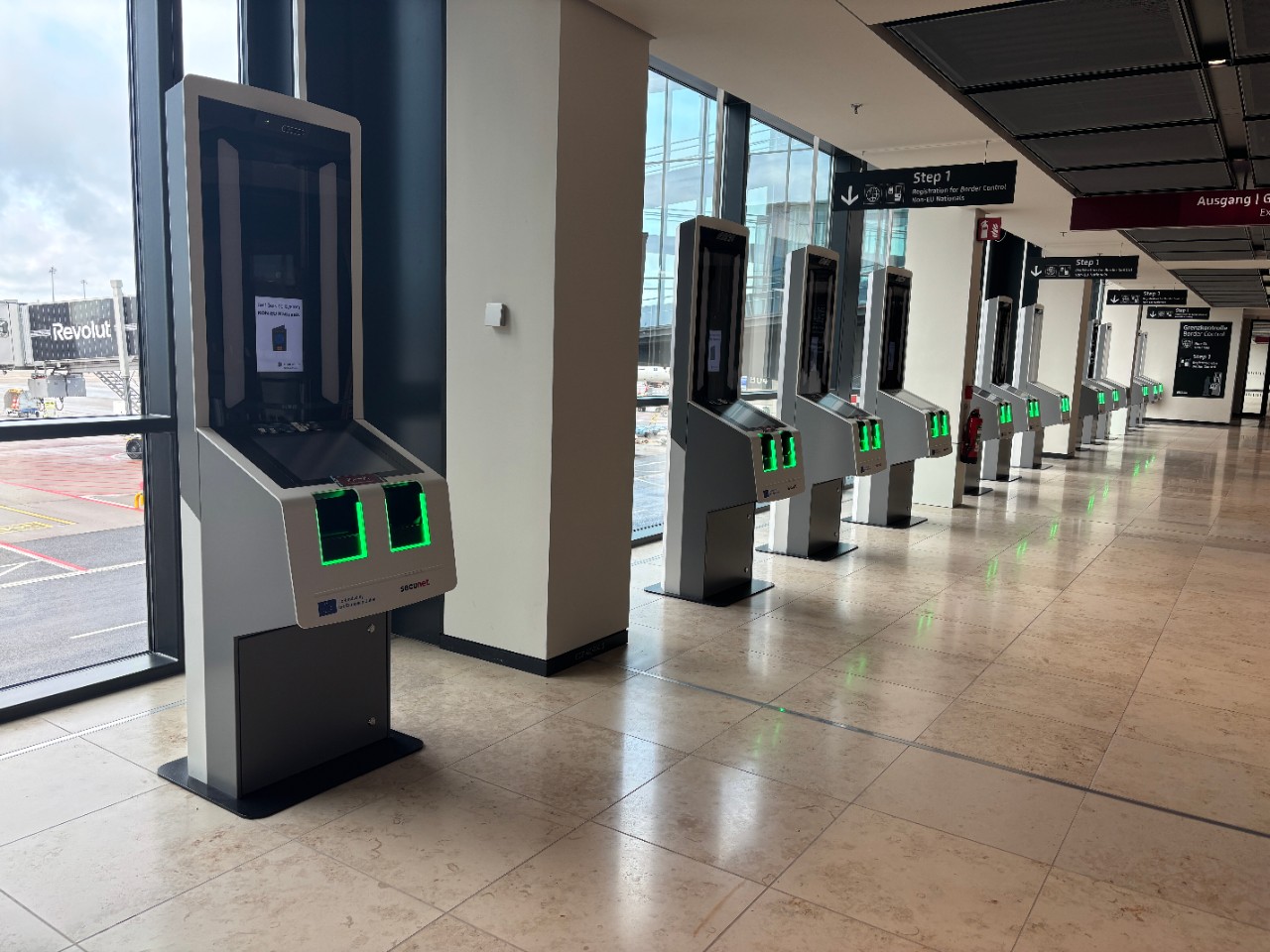The Europe-wide Entry/Exit System (EES) has been in force since 12 October 2025. EES has been gradually introduced at Berlin Brandenburg Airport since 2 December 2025. Upon entry, passengers can pre-register at automated kiosks before proceeding to the border control officers. The introduction is expected to be completed in Germany by 10 April 2026.
Who is affected by the EES?
- Nationals from non-EU countries staying in the European Union for a short period (up to 90 days within a 180-day period) must complete the new entry and exit procedure.
- The EES does not apply to EU citizens or citizens of associated Schengen countries (Iceland, Norway, Switzerland, Liechtenstein).
- Nothing will change for EU citizens and people with a German residence permit.
What will change?
- Instead of stamps in passports, entries and exits will be recorded digitally in future. Among other things, personal data, a facial image and fingerprints will be stored.
- Since 2 December 2025, registration has initially been taking place at the border control desk. Upon entry, passengers can pre-register at automated kiosks before proceeding to the border control officers.
Further information
Film with helpful information (YouTube)
Please also take a look at the FAQs.
Die drei Schritte der EES-Registrierung
Verfügbar am BER am Januar 2026. Vorher erfolgt die Registrierung ausschließlich am Grenzkontrollschalter durch Beamte der Bundespolizei.
- Bitte entfernen Sie alle Accessoires, um einen reibungslosen Ablauf zu gewährleisten.
- Bitte halten Sie Ihren Reisepass bereit und nehmen Sie ihn aus der Hülle.
Frequently asked questions
The Entry/Exit System (EES) is a new EU-wide system that automatically records when non-EU nationals enter and leave the Schengen area. It replaces manual passport stamping and helps monitor the permitted duration of short stays, ensuring compliance with entry and exit regulations.
- The EES applies to non-EU nationals entering the Schengen area for short stays of up to 90 days within a 180-day period, provided they do not hold a residence permit or a long-stay visa.
- EES does not apply to EU citizens or citizens of associated Schengen countries (Iceland, Norway, Switzerland, Liechtenstein).
- Nothing changes for EU citizens and people with a German residence permit.
Self-Service Systems are automated kiosks located before border control. They allow travelers to scan their passports, provide required travel information, and register biometric data such as fingerprints and a facial image.
The EES does not apply to EU citizens or citizens of Schengen-associated countries (Iceland, Norway, Switzerland, Liechtenstein). It also does not apply to their non-EU family members who hold residence cards, or to travelers with residence permits or national long-stay visas issued by a Schengen country.
When entering the European Union at Berlin Brandenburg Airport, self-service systems are available. Please use these to pre-register your details by scanning your passport and capturing your biometric data.
Once you have completed this step, proceed to the border control desk to complete the regular entry process. Border guards will check your registration and carry out the formal entry check.
When leaving the EU, no self-service systems are available. Please proceed directly to the border control desk.
The Entry/Exit System records the following information:
- personal data such as surname, forename, date of birth, and nationality
- passport number, issuing country, and type of travel document
- biometric data including a facial image and four fingerprints (excluding thumbs)
- travel details such as entry and exit dates, border crossing points, and the duration of your authorized stay
No, if your biometric data was already registered during a previous trip and is still valid (within a 3-year retention period), you do not need to register again. However, each entry and exit is still automatically recorded by the EES.
Your personal data is processed in accordance with the EU General Data Protection Regulation (GDPR). The EES stores your data solely for border control purposes and will not be used commercially. Data is stored for three years, or five years in case of an overstay. Only authorized authorities may access this information.
The EES is designed in full compliance with EU data protection laws. All personal and biometric data is encrypted, stored securely, and accessible only to authorized personnel under strict legal regulations.
No, every traveller must register individually, including children. Parents or guardians can assist children (aged 12 and above) with registration at self-service kiosks. Children under the age of 12 are registered at the manual border control.
You can keep piercings and glasses on during registration as long as your face remains clearly visible. If the system cannot capture a clear image, border staff may ask you to remove certain items temporarily.
If you refuse to provide biometric data, your registration cannot be completed, and you may be refused entry into the Schengen area. Providing this data is a legal requirement for non-EU nationals entering the EU.
BER offers digital self-service kiosks at the point of entry where travellers can scan their passports and register their biometric data. These systems can only be used if you have a biometric passport.
Yes, travelers should expect longer waiting times, especially during the initial implementation phase. Even in the long term, border control may take more time due to the additional steps required for EES registration.
If your biometric registration fails at the self-service kiosk, please proceed to a manual border control desk. Border officers will complete your registration there.
If your biometric registration fails at the self-service kiosk, please proceed to a manual border control desk. Border officers will complete your registration there.
Your personal data is stored in the EES for three years after your last border crossing. If you overstay or violate entry conditions, your data may be stored for up to five years.
Yes, children are also required to register in the EES. For all non-EU nationals, including infants, an EES file will be created containing passport details and a facial image. Fingerprints are only required for travelers aged 12 and above. Specific rules apply to minors and may vary by country; please refer to official guidelines for more information.
Each traveler, including minors, must have their own valid travel document in order to be registered in the EES. If a child is only listed in a parent’s passport and does not have an individual document, EES registration is not possible. In such cases, entry may be denied or subject to manual processing, depending on the rules of the border authority. Please check with your airline or relevant embassy in advance.
You will find the self-service systems near the border control points. Please follow the signs.
- Travellers without a biometric passport
- Children under 12 years of age
- Travellers with disabilities
Your data will be recorded directly at the border control desk.
No prior registration is required for the European Entry/Exit System (EES), which will come into force on 12 October 2025. Upon entry, passengers can pre-register at automated kiosks before proceeding to the border control officers.
The European Travel Information and Authorisation System (ETIAS) is expected to become operational at the end of 2026. Visa-free travellers will then have to apply for an electronic travel authorisation, which includes a security check, before travelling. This registration will be mandatory and must be completed before entry.



